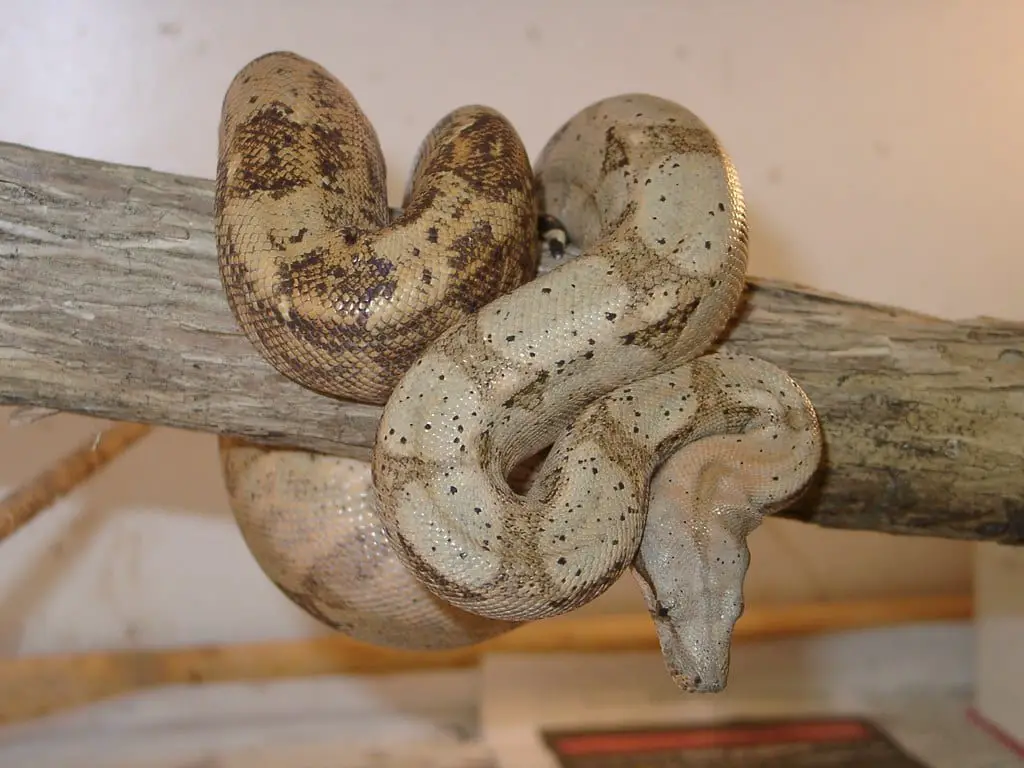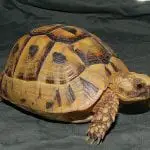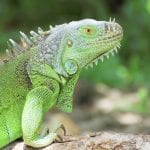Scientific Facts
| Common Name | Hog Island Boa |
| Scientific Name | B. c. imperator |
| Captive Lifespan | Over 20 Years |
| Size | 4 – 6 feet |
| Mass | 13 Ib. |
| Habitat | Tropical rainforests |
| Country of Origin | Hog Islands, Honduras |
Physical Description
As compared to common boa constrictors, Hog Island boas are visibly smaller in size, with adults typically reaching about 4 – 6 feet in length.
With a wider jar line and heat pits located along the very top of the lip, the head of B. c. imperator species is flat. Meanwhile, the eyes have a distinguishable, two-tone appearance, and a vertical pupil.
Depending on their mood, temperature, health, as well as day/night cycle, the body coloration of Hog Island Boas can change. As compared to other species, the scales of these island snakes are much softer and smoother.
Male Hog Island boas appear somewhat slender, while females are bulkier and heavier-bodied. The tail coloration can range from orange to salmon-pink.
Unlike boa constrictors, Hog Island boas have fewer anal and dorsal scales.
Types
Being an island variety of common boa, and therefore, often confused with common boas, Hog Island Boas are non-venomous snakes that belong to the Boidae family, Boa genus.
Apart from the B. c. imperator populations that are native to the Hog Islands (Cochinos Cays), off Honduras’ northern shore, other boa imperator populations include those found in Nicaragua. Nicaraguan boa imperators are smaller in size than B. c. constrictor species.
Boa imperator subspecies occupying Colombia are also known to include a number of dwarf insular populations, representing the smallest members of boa imperators globally, occupying the Sonoran Desert, as well as various Caribbean Islands.
Habitat & Lifespan
Native to Cayos Cochinos (Hog Islands), these snakes are known to acclimatize fairly well to a variety of environmental conditions. However, the preferred type of habitat for Hog Island boas is tropical rainforests, where these reptiles can find reliable cover from predators, while also feasting on plenty of prey, and enjoying proper humidity and temperature levels, especially as compared with arid desert habitats where other boa imperators can be found.
These snakes are reported to live for over 20 years in captivity.
Behavior
Hog Islands boas, similarly to other boa imperators, are known to prefer to lead a rather solitary life, avoiding interaction with other snakes, with the only exception being the mating season. These reptiles are semi-arboreal, sometimes foraging by climbing into bushes and trees.
With age, these snakes become majorly terrestrial, which is due to their bodies becoming heavier over time.
Much like all other snakes, Hog Island boas’ behavior becomes more unpredictable during their shed cycle, since the lubricating substance found between new and old skin leads to the snakes’ eyes appearing opaque, milky or blue, and most importantly, it deprives the snakes of their excellent eyesight during shedding. Because of not being able to see clearly, when shedding Hog Island, snakes become more defensive than they would usually be.
Caging
- Because of being significantly smaller in size than common boa constrictors, caging Hog Island boas requires less space, and hence, these snakes are also easier to manage. However, the size that adults attain should not be underestimated, and the larger cage provided by the caregiver, the better for the reptile.
- As a general rule of thumb, the length of the enclosure + the depth of the enclosure should at least equal the length of the snake. Typically, average-sized adults will do fine in a cage measuring a minimum of 4 feet long and 2 feet wide, but a larger specimen will require more space.
- Babies can be started in 10-gallon cages, with the size of the cage being increased at around one year old.
- Juveniles should be kept in at least 29-gallon terrarium, although opting for larger enclosures is highly recommended. In fact, it is perfectly fine to house young Island Hong boas in a large-sized enclosure that will last them throughout adulthood, as long as you make sure to provide plenty of hiding places arranged in different areas within the cage. As the young snake matures and grows in size, some of the initial hiding spots should be simply removed, thus, opening more space for adults to thrive.
- If possible, walk-in type of enclosures is strongly recommended. For such enclosures, slidable glass panels will work a fantastic job, thanks to allowing the caregiver to easily view the enclosure without having to open it at all times.
Substrate
- Orchid bark chips make an excellent substrate for B. c. imperator species. First off, bark chips hold moisture well, thus, helping the reptile maintain humidity levels within the optimal rates. Secondly, being darker in color, this type of substrate further makes up for setting off the snake’s coloration beautifully.
- Other suitable types of the substrate include beech chip, aspen, coconut bark, cage carpet, and lignocel.
Temperature, Lighting & Humidity
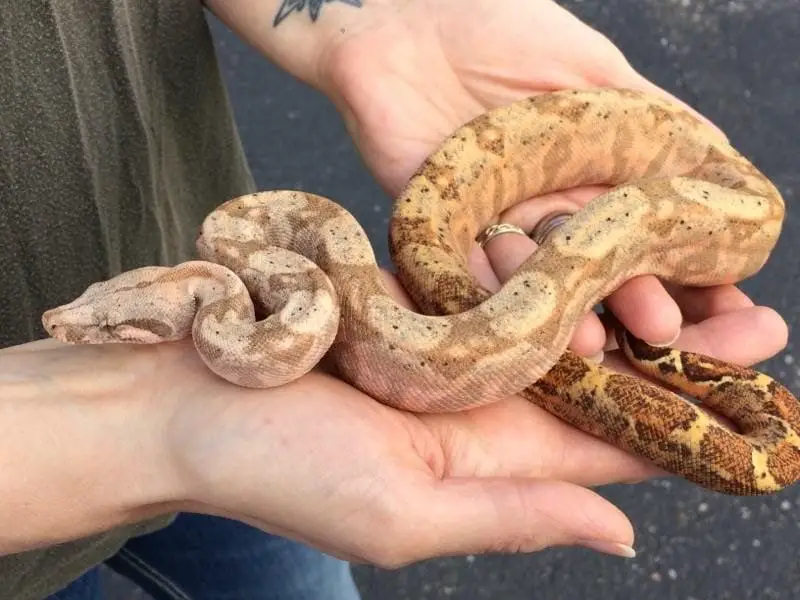
- As a general rule of thumb, Hog Island boas do not necessarily require any lighting. However, since the caregiver is to certainly wish to be able to see the snake, artificial lighting is highly recommended.
- Modern-day LED lighting can work wonderfully. Utilizing LED lights will make up for great energy savings; thus, being kind not only to the caregiver’s wallet but also to the environment. Also, since LED lights do not generate much heat, they do not need to be guarded, and some can even automatically switch from daytime to nighttime lighting, coming in a wide variety of colors that will further enhance the aesthetics of the enclosure. Not the least, LED lights do not require regular replacement.
- Other lights that can work fine include incandescent lamps and fluorescent tubes. Do mind that incandescent lights must be guarded carefully, as they generate significantly more heat than LEDs and fluorescent lights. The fluorescent lights’ major drawback is that they need to be replaced more frequently than LEDs.
- As Hog Island Boas originate from tropical environments, they must be provided a reasonable level of heat, as well as humidity, in order to thrive in captivity. At the hot end of the enclosure (aka the hot spot), keep temperatures within the 95 degrees Fahrenheit range.
- Keep nighttime temperatures at the 75 – 80 degrees Fahrenheit range.
- To heat up the enclosure properly, caregivers can take advantage of a ceramic heat emitter. Do make sure that the heater is guarded, e.g., with a cage around it, so that the snake will not get into direct contact with the device since this can lead to nasty burns.
- Alternatively, to utilizing a ceramic heat emitter, a heat mat can be mounted on the end wall of the enclosure, thus, preventing possible thermal blocking.
- Keep humidity at about 60% and up to 70%. One easy way to maintain humidity within the optimal rates is to place a suitably-sized water bowl at the hot end of the enclosure. By doing so, water evaporation will make up for increased humidity without the need to utilize any other fancy devices. Do mind, though, that with this particular method for humidity maintenance, the water bowl should be changed on a daily basis.
- Another way to keep humidity within the desired range is to make use of hand misters.
Diet
The diet of Hog Island boa in the wild, just like with most boa species, is majorly made up by birds, frogs, lizards, and rodents. As the size of the snake increases with age, so does the size of the desirable prey items.
Eating Habits
Hog Island boas, similarly to other Boa species, are ambush predators. It is during the night when these snakes hunt, using constriction to incapacitate the prey.
In captivity, these reptiles are known as good feeders.
Feeding small Hog Island boas with mice is a good idea. However, it is strongly recommended to quickly switch to appropriately-sized rats as the snake grows in size, respectively, since there is a tendency to get them habituated to mice.
In general, a small baby, as well as juvenile B. c. imperator should be fed once or twice a week, while larger ones should be fed every 7 to 14 days. Mind that there might be exceptions to the suggested feeding routine, so it is best to monitor the snake and let the animal “tell” you when it needs more or less food.
Caregivers are also highly encouraged to use tongs for feeding. That’s because when the warmth of a human’s hand is coupled with the tempting smell of food, this can often lead the reptile striking at the wrong thing, causing the keeper pain that could have been easily avoided.
When Hog Island boas are preparing to shed, they will typically refuse to eat, and that’s totally fine. Return to the regular feeding routine as soon as the snake has successfully shed its skin.
Sleeping Habits
Hog Island boas are nocturnal creatures, so it is during the night when they become active. However, it is not uncommon to spot them basking during the day, too, especially when nighttime temperatures are low, causing the reptile to thermo-regulate its body temperature the morning after.
Water
Keepers want to ensure that a Hog Island Boa always has access to clean, freshwater. It is best to use a non-porous water bowl.
Also, don’t forget to scrub the bowl thoroughly at least once a weak in order to prevent the buildup of bacteria slime. Place the water bowl on the cooler end of the enclosure. Another water bowl placed at the warmer end can be used to raise humidity levels.
Development and Reproduction
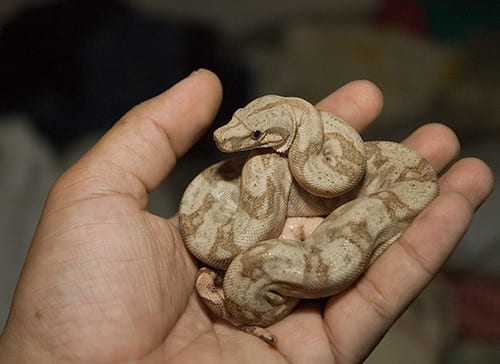
Typically, the female Hog Island boa is ready for breeding as soon as she reaches 3 – 3 ½ years of age. Males are ready to breed much earlier, as soon as they reach 1 ½ year of age.
However, it is the size of these snakes that is actually a crucial factor in determining their breeding capabilities. Although the exact size at which these snakes are mature enough to breed is not set in stone, and there are many possible answers, in general, they are ready to mate successfully when they exceed the 12 pounds mark.
How to Breed
Before one is to attempt breeding Hog Island boas, he/she is strongly encouraged to seek professional, first-hand guidelines by experienced, reliable breeders.
The most important factors that determine the success of the breeding attempt with Hog Island boas include the following:
- Both the male, as well as the female, must be sexually mature. Whether the snakes are sexually mature can be hard to tell without any previous experience in breeding these reptiles.
- Both of the snakes should have reached an adequate size. Breeding smaller-sized Hog Island boas will highly likely turn out to be an unsuccessful attempt, threatening the well-being of the reptiles.
Important Notes
If the female is not sexually mature and/or not adequately sized for breeding, she can die because of not being able to carry her clutch to term. Also, even if the clutch is carried to term, it can be very small, or all of the babies inside may be dead. Not the least, the life expectancy of females subjected to improper breeding will be shortened.
Handling
- Although it is not accurate to claim that Hog Island boa snakes enjoy being handled, they certainly don’t mind. These snakes can be handled daily. As these creatures are fairly docile, they can tolerate handling better than many other snake species, as long as the caregiver takes the time to get the snake well-used to being handled.
- As a rule of thumb, the more secure a Hog Island boa is to feel in the caregiver’s presence, the less likely it is for the reptile to attempt striking or escaping. Patience is key. The snake will feel more secure if more points of contact on the reptile’s body are provided by the keeper during handling.
- Never approach the snake from the front of the head zone. Instead, always approach it from behind. Since these snakes have plenty of sensors that are facing forward, and are highly tuned hunting, e.g., eyes, tongues, heat pits, and nostrils, if the caregiver’s hand is to be shot in from the front, this can easily make the snake feel threatened, striking and inflicting a nasty bite in return.
- Whenever you are about to handle a Hog Island boa, please remember that the snake did not really ask you to pick it. The least you can do is to make sure to treat the animal with the utmost respect. Do not force it.
- Adult Hog Island snakes that have become well-used to their caregiver, as well as to being handled, are known to start to trust the keeper more, thus, sometimes allowing for the top of the head zone to be gently touched, without jerking back in return.
How to Treat and Prevent Possible Health Issues

1) Burns
Make sure the snake cannot get in direct contact with the ceramic heat emitter. Also, it is best to stay away from using hot rocks, since they tend to heat unevenly, causing serious burns in return.
2) Overheating
As a rule of thumb, overheating is known to damage a Hog Island boa much more quickly than under heating possibly can. It is the caregiver’s responsibility to ensure the comfort and well-being of his/her pet adequately. In any case, always use a reliable device to measure temperature and humidity, and forget about guessing. While on/off thermostats used for heat mats are fairly affordable, pulse proportional thermostats used with ceramics are much more precise, providing superior control.
3) Respiratory infections
As with other reptiles, respiratory infections can be triggered due to the Hong Island Boa being exposed to colder temperatures. Fortunately, such issues can be avoided, provided the caregiver is to carefully maintain temperatures within the optimal range at all times.
4) Shedding issues
Shedding-related issues may occur if humidity is below the recommended rates. If humidity is maintained within the 60% – 70% range, shedding should run smoothly, without any troubles.
5) Feeding-related issues
If a Hog Island boa refuses to eat and is not currently shedding when refusing to eat is OK, then the snake most probably feels insecure, which is due to an incorrectly set up enclosure.
Do not feed these snakes with too large rats or mice. Doing so may result in the snake refusing food, just to regurgitate it later on. Also, it can lead to even greater harm, associated with the sharp claws of larger rats/mice damaging the insides of the reptile.
In the case, a Hog Island boa doesn’t eat, remove the rodent from the enclosure as soon as feasible. Do not let the rodent hang in the enclosure for too long, as rodents are known to bite snakes, causing serious injuries and sometimes even killing the reptiles.
Ultimately, do not feed more than necessary, as this can lead to unhealthy body weight.
Possible Dangers to Humans
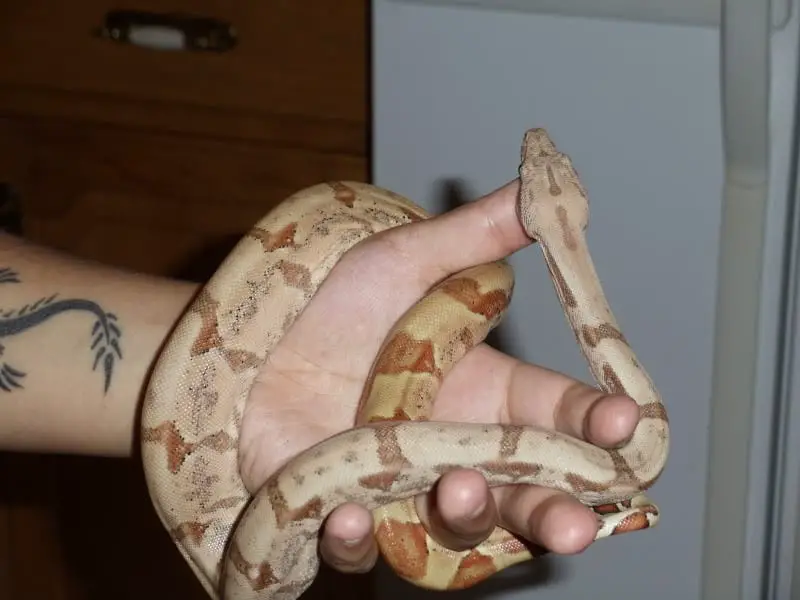
Hog Island snakes are non-venomous. Even though their bite can be painful, and especially the bite of larger B. c. imperator species, it is rarely seriously dangerous to humans, as long as the infected wound is treated adequately.
A Hog Island boa will only strike if improperly treated, and whenever to perceive a threat, so bites are fully avoidable and are mainly based on the caregiver’s attitude towards his/her reptile pet.
As with other reptiles, do not leave children unattended with a Hog Island boa.
Also, always wash your hands carefully after cleaning the snake’s feces and/or touching it, since even though rarely, snakes can transfer Salmonella to humans.
Availability: How to Get a Hog Island Boa?
The illegal pet trade is one of the leading causes that almost made the populations of Hog Island boas in the wild go fully and irreversibly extinct some years ago. Although nowadays the populations of these snakes are much more stable, reptile enthusiasts only want to get a Hog Island boa from reputable, trustworthy vendors who can provide a guarantee for the reptile’s health status and captive-bred origin.
Fun Facts
- The Cayos Cochinos locals who share the two large islands where Hog Island boas live in the wild call these snakes “boa rosada,” because of these snakes lacking black pigment. Hog Island boas are naturally hypomelanistic, and it is due to the reduced levels of melanin why they are visibly more lightly colored, as compared to other Boa imperator species. However, Hog Island boa snakes do retain the distinctly darker tail, which is characteristic for most of the boa imperator species.
- Being a unique type of snake, deeply treasured as a pet because of its beautiful coloration and docile nature, the Hog Island boa populations in the wild were once believed to have become 100% extinct. Fortunately, thanks to dedicated, hard work by master herpetoculturists and breeders, among other experts, the Cayos Cochinos populations are now estimated to be much healthier, with the future of these extraordinary creatures looking more promising.
- The fast movement that characterizes the way Hog Island boas tend to quickly strike and bite if approached from the front is called “head shy.” Although this often tends to scare many people from getting in closer contact with these mesmerizing captive pets, most of these snakes will get over their head shy “syndrome” over time, provided with proper care and gentle handling.
How to Take Care of a Hog Island Boa
- First and foremost, the smartest way to tell whether you will be able to take proper care of a Hong Island Boa is to carefully consider the reptile’s requirements, as well as its temper, prior to purchasing one. Also, before you obtain one of these beautiful snakes, make sure you have already set up the enclosure, including all necessary equipment, testing whether lighting fixtures function properly and whether temperature and humidity are within the optimal rates for a week or so prior to placing your newly acquired boa inside.
- It is a great idea to include live plants, such as living willow branches and bamboo, just to name a few, within a Hog Island snake’s enclosure. Provided with light and soil, plants will keep growing and developing over time, while caregivers who do not really have a green thumb can simply add new live plants as soon as the initial ones die off. Adding live plants will not only enhance the aesthetical, natural looks of the terrarium but will also greatly contribute to the reptile’s comfort.
- Broken branches and/or logs can be also added, as these will serve as good hide spots, boosting the snake’s sense of security, and making up for a more docile pet. Also, placing various branches/perches will help to increase the snake’s activity, as well as to help it sustain proper body weight, by allowing it to practice its arboreal skills.
- For glass tanks, several humid hide areas placed on the cooler and on the warmer end of the enclosure, and equipped with some damp moss, are highly recommended for baby boas. These will help the baby snake feel much more comfortable and secure by having a humid place of varying warmth/coolness to hide whenever needed.
- Clean the terrarium as necessary, minding that high hygiene is key to taking the best care of Hog Island boa snakes raised in captivity. Several times a week, you want to clean out any existing fecal matter. Change the bedding completely every month, and provide clean, fresh water at all times.
- For cleaning the inside of the enclosure, use high-quality reptile cleaner.
FAQs
Do Hog Island Boas Make Good Pets?
Hog Island Boas can make wonderful pets. They are brightly colored, non-venomous, fairly docile in nature, and they are known to perform great when introduced to a proper captive environment. Before purchasing your first Hog Island boa pet, though, make sure to consider whether you will be able to take the best care of these amazing reptiles since this is a long-term commitment and do never purchase any other Hog Island boa but a captive-bred one.
How Long Do Hong Island Boas Live?
Hog Island boas have the reputation of being quite long-lived reptiles. Hog Island boas can live for well over 20 years in captivity, given the proper care.
Are Hog Island Boas Aggressive?
No, it is not accurate to state that Hog Island boas are aggressive in general. Although these snakes can and do strike quickly, inflicting a painful bite, they will only do so if feeling threatened, insecure, and/or because of being poorly treated.
What is the Difference between Hog Island Boa and other Boas?
Being an island variety of the common boa, Hog Island boas are actually quite similar to their close common boa relatives. However, Hog Island boas’ body coloration is different, as these reptiles are naturally low in black pigment, giving out an incredible muted pattern of light pinks and browns that may even range to blue or orange. Also, the size of Hog Island snakes is smaller than that of common boas.
How Big Do Hog Island Boas Get?
Usually, female Hog Island boas get as big as 5 – 6 feet on an average, while males are a bit smaller, typically between 4 – 5 feet. As a comparison, female boa constrictors are known to grow to about 7 – 10 feet.
How to Take Best Care of a Hong Island Boa?
To take proper care of a Hong Island boa, the keeper must ensure that daytime temperatures are kept within the 85 – 90 degrees Fahrenheit range, with a basking spot in the 95s Fahrenheit, while nighttime temperatures should drop down to 75 – 80 degrees Fahrenheit. Treat and handle the Island boa pet with respect, and keep the enclosure clean. Humidity should be maintained within the 60% – 70% level, and the reptile pet should be provided a healthy feeding routine.

